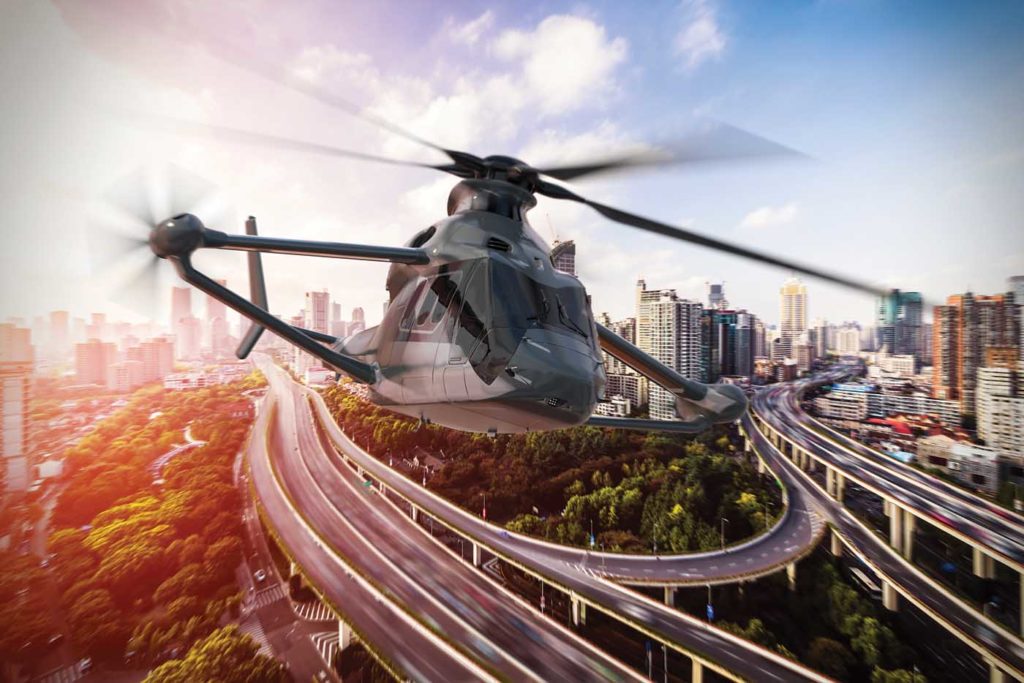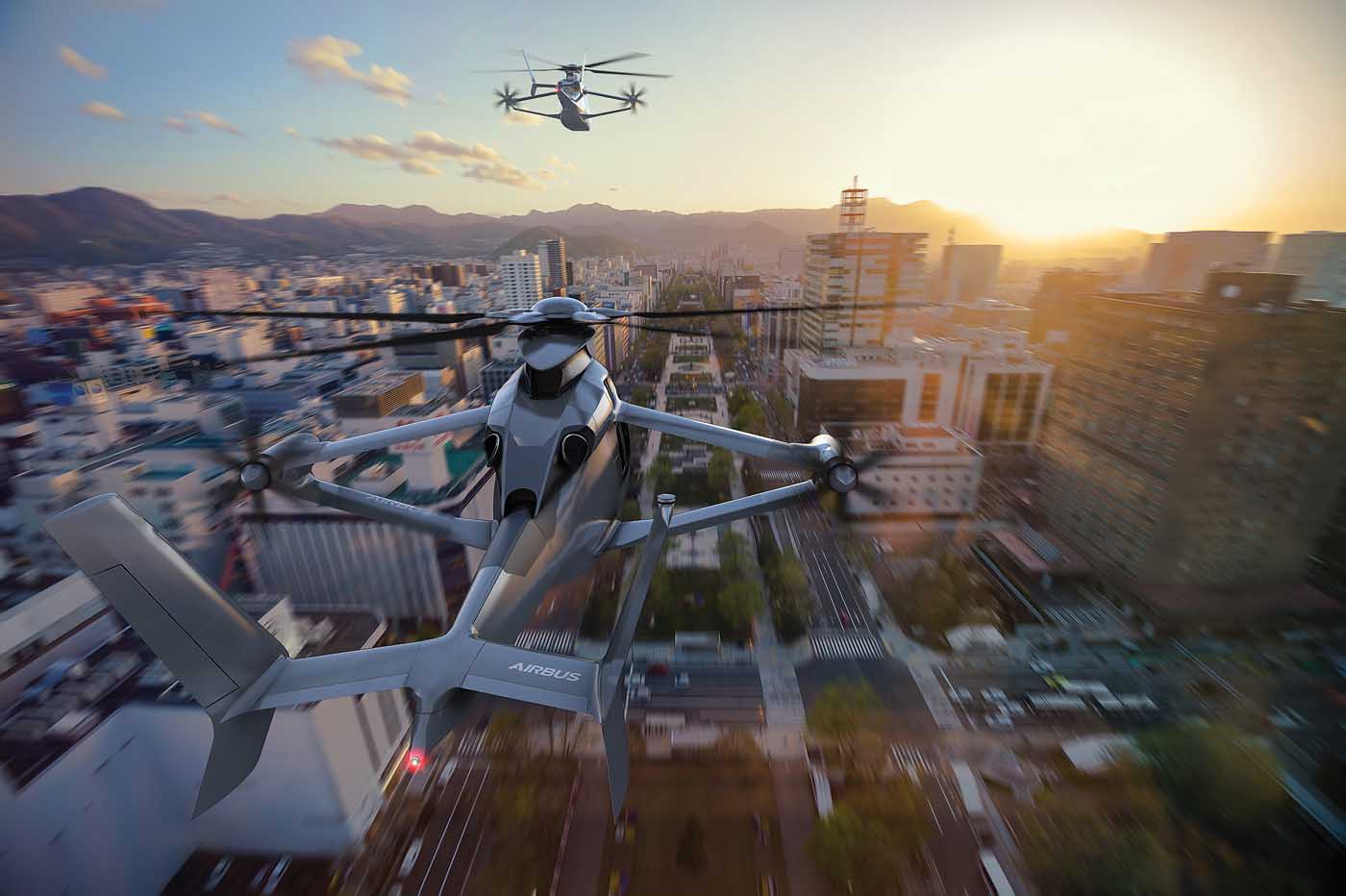Imagine flying in a single-engine helicopter over mountainous terrain. Now, imagine your engine quitting. Today, your circle of available forced landing sites would be small and directly beneath you, but since we’re imagining things, suppose you could fly for another few minutes. A flat spot appears on a ridge just in front of you. You make an approach and land safely.
It’s a compelling vision, and one that, thanks to advances in electrification, is well on its way to becoming a reality. The same technologies that are enabling a new generation of fully electric aircraft have also opened the door to hybrid-electric systems for conventional rotorcraft, including backup systems that could continue flight on battery power in the event of a thermal engine’s failure.

Helicopters require so much power that batteries are unlikely to replace turbine engines in the foreseeable future, even considering the most optimistic projections of battery performance. However, hybrid systems that use batteries to assist or complement turbine engines in multiple ways could become a standard feature on conventional helicopters within the next decade.
Meanwhile, the potential for hybridization is also transforming the design space for future high-performance rotorcraft, which will be faster, quieter, and greener than the helicopters that exist today.
“I think this is a really exciting time,” said Jason Hurst, vice president of innovation at Bell. “The design tools and the design freedom that [electrification] gives you opens up completely new thoughts and concepts. . . . I think it will be really interesting to see what transitions over to more traditional helicopters and what those look like going forward.”
Bell has already provided an example of just how radically electrification could transform conventional rotorcraft through its electrically distributed anti-torque (EDAT) system. Revealed in early 2020, the system was installed on a Bell 429 demonstrator, replacing the conventional tail rotor with a shroud containing four small electric fans.
EDAT could offer several advantages over traditional tail rotors, including redundancy, lower operating costs, and reduced noise. Hurst said Bell is continuing to explore ways to optimize the system before making a decision on when and how to bring it to market.
“The world of electric motors, electric propulsion is advancing very rapidly. And so we’re characterizing what the state-of-the-art is on those technologies and looking to see how that would inform the future configurations,” he said, explaining that Bell is aiming to find the “sweet spot” in terms of technology and operator benefit.
While Bell has yet to disclose any other hybridization research efforts, Hurst confirmed that the company sees battery backup systems as a promising avenue to enhance the safety of single-engine helicopters in particular.
“A lot of the technologies that we’re developing, our aim [is] how do we make commercial aircraft, single- and twin-engine aircraft, safer for the public? We all read the accident reports and ultimately want to get the commercial aircraft to [the same] level of safety and public acceptance as a commercial airliner,” Hurst said.
Airbus has already revealed considerable progress on an initial version of an engine backup system, which it has been testing on Flightlab, its H130 technology demonstrator. This version can provide around 100 kilowatts of power for 30 seconds, which isn’t enough to sustain normal flight after engine failure. However, it kicks in immediately to prevent rotor rpm from dropping, and can enable a wider autorotation cone, easier final flare, and softer landing, improving the odds that an emergency landing will be successful.
The system consists of a battery and inverter controller installed in the helicopter’s right-hand cargo bay, a DC-to-DC converter in the tailboom, and an electric motor and reduction gearbox mounted to the auxiliary drive pad of the main gearbox housing. While the system adds weight to the aircraft, this would likely be more than offset by an increase in the maximum takeoff weight, which on the H130 is currently limited by its autorotation capability.
“We are really working to bring this performance benefit together with the safety benefit, which is probably really good value for customers using single-engine aircraft,” explained Luca Cossetti, an Airbus innovative power solutions specialist, at the European Rotors conference in November.
Looking to the future, Cossetti said, a more powerful version of the engine backup system could enable electric flight for a few minutes, allowing single-engine helicopters to safely operate over congested areas or hostile terrain. He suggested that hybridization could also reduce noise — by allowing the speed of the main rotor to be reduced without risking a catastrophic rpm drop in the event of engine failure — plus provide a “power boost” option to enhance performance.
Meanwhile, Airbus is preparing to demonstrate an “Eco Mode” hybrid option on its high-speed Racer demonstrator, the compound helicopter it is developing in the framework of the European Union’s Clean Sky 2 program. The aircraft, which is expected to make its first flight later this year, will be equipped with two Safran Aneto-1X engines, which like most turbine engines are more efficient at higher power settings.
Because the Racer incorporates a wing, it will require relatively less power even at cruise speeds of 180 knots (330 km/h), which would ordinarily mean two engines running inefficiently with low power output. In Eco Mode, one engine is dropped to a certain minimum speed while the other is run at a higher power setting, reducing total fuel burn by 15 percent or more.
An electric motor on the gas generator stage enables the “sleeping” engine to be brought back up to full speed in just a few seconds should the other engine fail — a feature that could become standard on future twin-engine helicopters.

According to Tomasz Krysinski, vice president of research and innovation for Airbus Helicopters, reducing fuel burn has benefits that extend beyond the immediate savings. Through a combination of aerodynamic improvements, more efficient turbine engines, and hybridization, Airbus thinks it can reduce fuel burn by as much as 50 percent compared to today’s helicopters.
That could make it more attractive for operators to use sustainable aviation fuel (SAF) for the balance of their fuel needs, even if SAF remains more expensive than conventional jet fuel. It could also pave the way for future use of hydrogen as a fuel, which is difficult to store in large quantities on small aircraft like helicopters.
“We must always have in mind there is a customer behind it. We cannot supply the system [if] we just don’t bring value to the customer.”
Leonardo is also exploring hybridization in helicopters through Kopter, the Swiss startup it acquired in 2020. The company plans to demonstrate a battery backup system using its single-engine AW09 helicopter now in development. According to Kopter chief technology officer Michele Riccobono, his team has completed the feasibility analysis and defined the architecture for the system, and is now working toward full-scale bench tests next year, with the first flight of the hybrid prototype expected a couple of years later.
“We firmly believe that we can achieve certification of our engine backup system concept within the end of this decade,” Riccobono told Vertical. “The current concept will also support for more extended electric flight as long as the battery technologies . . . reach the required power and energy densities.”
The limitations of today’s batteries aren’t the only challenges facing developers of hybrid systems. These systems will require larger batteries and higher levels of voltage and current than today’s aviation electrical systems, creating new integration and safety issues that will need to be addressed both by designers of these systems and the regulators who approve them.
“The main challenges of electric hybridization are the density of electrical components and storage devices, and safety to protect passengers and systems from the effects of the high voltage (several hundred volts) that powers the electrical machines,” Pascal Dauriac, vice president of research and technology programs for Safran Helicopter Engines, explained by email. “New failure modes such as partial discharges or electric arcs require the development of specific electrotechnical protections.”
From an aircraft certification perspective, the helicopter industry will likely benefit from the work being done in the electric vertical takeoff and landing (eVTOL) space, which is actively grappling with standards for batteries, electric motors, and associated systems.
Riccobono thinks we’ll also need to see “the creation of a suitable regulatory framework to boost the operational capabilities of single-engine helicopters with this kind of hybrid technology. This is vital to allow the operators to get the benefit of this new technology, which can balance the reduction of payload and slight increase of acquisition cost,” he said.
Krysinski likewise emphasized the importance of creating value for operators, whether through improvements in performance, operational flexibility, or both. “We must always have in mind there is a customer behind it,” he stressed. “We cannot supply the system [if] we just don’t bring value to the customer.”

According to Bell’s Jason Hurst, understanding the missions being performed by helicopters today will be key to creating technologies that keep these platforms relevant long into the future.
“I think the key is really understanding the use cases,” he said. “And then because we have these new design tools and the new degrees of freedom, it’s doing some optimization and taking a different approach of: ‘How can you solve those problems differently than you’ve done?’ ”





